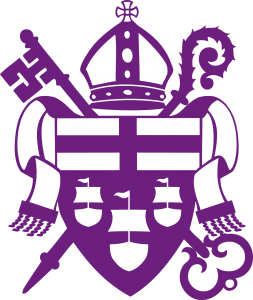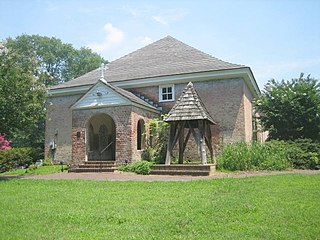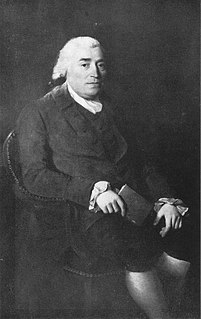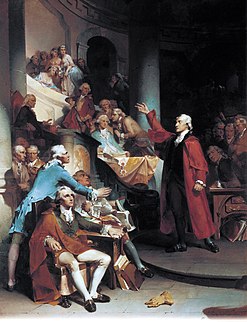
Truro Anglican Church is an Anglican church in Fairfax, Virginia, USA.

The Diocese of Virginia is a diocese of the Episcopal Church in the United States of America encompassing 38 counties in the northern and central parts of the state of Virginia. The diocese was organized in 1785 and is one of the Episcopal Church's nine original dioceses. However, the diocese has origins in colonial Virginia. The diocese had 73,108 members and 182 congregations.

Christ Church is an Episcopal church located at 118 North Washington Street in Alexandria, Virginia. Constructed as the main church in the Church of England's Fairfax Parish, the building was designed by Col. James Wren, a descendant of Sir Christopher Wren. To finance construction of the church, the Fairfax Vestry raised 31,186 pounds of Oronoco tobacco from parishioners. Construction began in 1765, under the direction of James Parsons. After four years, the church was still unfinished. The vestry relieved Mr. Parsons of his duties as overseer of the construction. John Carlyle accepted the position and handed the keys of the completed building over to the vestry in February 1773.

Pohick Church is an Episcopal church in the community of Lorton in Fairfax County, Virginia, United States. Often called the "Mother Church of Northern Virginia," the church is notable for its association with important figures in early Virginian history such as George Washington and George Mason, both of whom served on its vestry. As Pohick Episcopal Church, it was added to the National Register of Historic Places in 1969.

The Falls Church is an historic Episcopal church, from which the city of Falls Church, Virginia, near Washington, D. C., takes its name. The parish was established in 1732 and the brick meeting house preserved on site dates to 1769.

Thomas John Claggett was the first bishop of the newly formed American Episcopal Church, U.S.A. to be consecrated on American soil and the first bishop of the recently established (1780) Episcopal Diocese of Maryland.

Martyn Minns is an English-born American bishop, serving in the Anglican Church of Nigeria. He was the founding missionary bishop of the Convocation of Anglicans in North America (CANA), under the patronage of the Anglica Church of Nigeria, until his retirement in January 2014. Prior to becoming a bishop, he served as rector of Truro Church in Fairfax, Virginia, in the United States.
Broad Run is a tributary of the Potomac River in Loudoun County, Virginia. The creek, located between Goose Creek and Sugarland Run, principally drains portions of eastern Loudoun County, as well as a small portion of western Fairfax County.

The Northern Neck Proprietary — also called the Northern Neck land grant, Fairfax Proprietary, or Fairfax Grant — was a land grant first contrived by the exiled English King Charles II in 1649 and encompassing all the lands bounded by the Potomac and Rappahannock Rivers in colonial Virginia. This constituted up to 5,000,000 acres (20,000 km2) of Virginia's Northern Neck and a vast area northwest of it.

Little Fork Church stands on a low knoll to the east of State Route 229 nine miles north of Culpeper, Virginia in a small grove of trees that enhances its naturally pastoral setting. The name Little Fork is taken from the junction of the Hazel and Rappahannock Rivers relatively close to the edifice. It is a large room church being 83 ½ feet east-west and 33 ½ feet north-south. Unlike most rectangular churches in Virginia, the pulpit stands directly north of the southern entrance door that is placed in the middle of the southern wall rather than in the far southeast of the building. Thus it shows some of the architectural characteristics of middle colony meeting houses such as those in Delaware as well as the Virginia Vernacular Church and the deep church.

"St. John's Church", "St. John's Episcopal Church", or "St. John's Episcopal Church, Broad Creek", is a historic Episcopal church located at 9801 Livingston Road in Fort Washington, Prince George's County, Maryland. It is a rectangular Flemish bond brick structure with a bell hipped roof. The interior features a barrel vaulted ceiling with an intricate support system.
Fairfax Parish was the ecclesiastical jurisdiction of the Anglican church in colonial Virginia with jurisdiction over part of Fairfax County with its central church located at The Falls Church. The parish was created in 1764 from Truro Parish.
Truro Parish was the ecclesiastical jurisdiction of the Anglican church in colonial Virginia with jurisdiction originally over all of Fairfax County. The parish had its central church at the Truro Church and the parish was named for the parish in Truro in Cornwall. The parish was created on November 1, 1732 from Hamilton Parish. It was divided twice: in 1748, Cameron Parish was formed and in 1764 Fairfax Parish was created. After 1765, Truro Parish covered southern Fairfax County until disestablishment ended the parish system by 1786.

Old Chapel is a historic Episcopal church building located near Millwood, Clarke County, Virginia. Old Chapel is now the oldest Episcopal church building still in use west of the Blue Ridge Mountains. It was listed on the National Register of Historic Places in 1973. In 2014, the Chapel Rural Historic District was recognized, and which encompasses both Cunningham parish churches, discussed below, as well as approximately 700 other structures and an area of nearly 10,500 acres.
The Church of the Epiphany is an Anglican church located in Chantilly, Virginia. It emphasizes "Encountering God through beautiful worship and believing prayer, building a multigenerational congregation that loves children and families and equipping every member to share the good news of Jesus Christ." Notable ministries and activities include a yearly free "Sports Camp" in Herndon for elementary-age students, bi-weekly worship and other ministry activities at the Arbor Terrace memory care home in Chantilly, and monthly donations of food that go home with students in need at Coates Elementary School in Herndon. Each year, Epiphany designates the congregation's Christmas Eve offering to a special project, alternating between supporting mission outside of the United States and meeting local needs in Fairfax County.

All Saints Church, or All Saints Episcopal Church, founded in 1742, is a historic Episcopal church now located at 106 West Church Street in the Historic District of Frederick, Maryland. It is the seat of All Saints Parish, Diocese of Maryland, which covers most of Frederick County, Maryland and once covered most of Western Maryland.
Tory K. Baucum is an American Anglican priest. He is married to Elizabeth Tyndall Baucum and they have three daughters.

Christ Church , or Christ Episcopal Church, founded in 1738, is the seat of Frederick Parish, Diocese of Virginia, which once covered half of the Shenandoah valley and western Virginia, including what became West Virginia. The current church building, the historic parish's third, was designed by Robert Mills, completed in 1828, and is the oldest church building in continuous use for religious purposes in Winchester, Frederick County, Virginia. It is a contributing building in the local Historic District which predates the National Register of Historic Places, and which has been expanded three times since 1980.






















